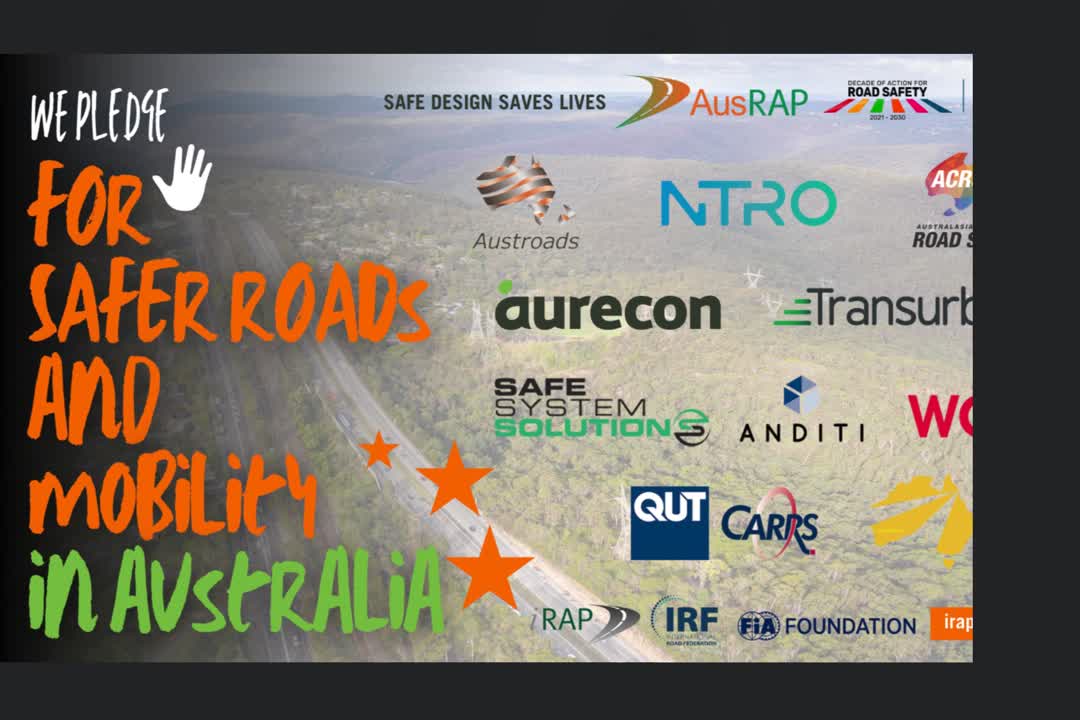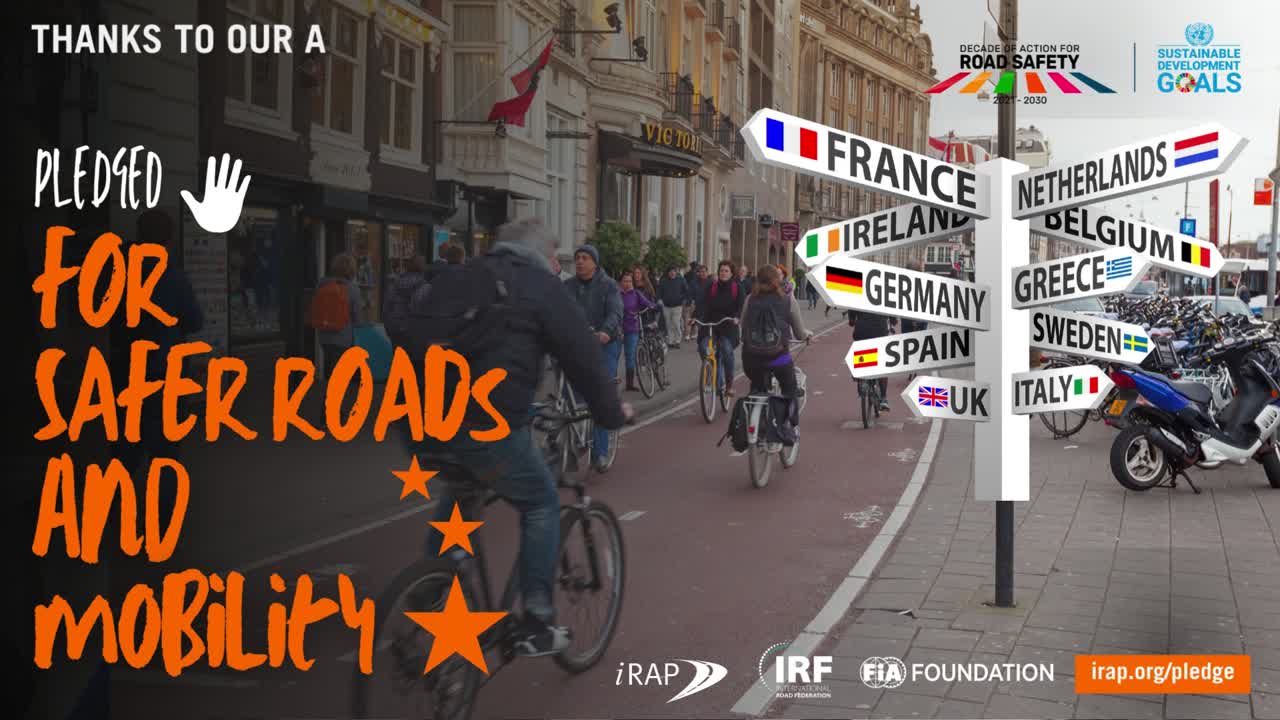FOR
SAFER ROADs
and
mobility
PLEDGE
Photo Credit: Estiara Ellizar | Bandung City, Indonesia 2023
Make your voice heard!
IN FEBRUARY 2025, LEADERS FROM AROUND THE WORLD GATHERED IN MOROCCO AT THE
GLOBAL MINISTERIAL CONFERENCE ON ROAD SAFETY TO AGREE ON ACTIONS TO REDUCE ROAD
TRAUMA BY 2030.
From August 2024, through to the event, organisations involved in designing and financing road infrastructure pledged their
commitments for safer roads, and supporting the Sustainable Development Goals (SDGs) to save lives.
#SaferRoadsPledge campaign outcomes were shared in Morocco and global attention was drawn to the importance of safe
design and commitments in support of UN Targets 3 and 4.
We have just five years remaining to achieve the UN Decade of Action goal to halve road deaths and injuries by 2030.
AS WE NOW LOOK AHEAD TO THE UN DECADE OF SUSTAINABLE TRANSPORT 2026 – 2035,
GLOBAL ADVOCACY, COMMITMENT AND ACTION TO ELIMINATE HIGH-RISK ROADS IS CRITICAL.
#SaferRoadsPledges are supporting ongoing discussions with road designers, financiers and road design software providers
for initiatives and programs which embed 3-star or better safety in road designs, projects and policies to save lives.
Join the call!
Make your voice heard.....
Role of all
Stand for safer roads that enable more sustainable mobility and commit our support for achieving the road safety
SDGs and the 12 UN Global Road Safety Performance Targets.
Role of government, private sector and funders
In support of UN Target 3, commit to including Road Safety Audits, Inspections and Star Rating Assessments for
new and improved road designs that aim for at least a standard of three-stars or better for all road users by 2030.
Role of government, private-sector road owners and funders
In support of UN Target 4, commit to undertaking crash-risk mapping and proactive safety assessments and
inspections that target investment in safer infrastructure and safer speeds that aim for more than 75% of travel
on existing roads to meet at least a standard of three-stars or better for all road users (or equivalent) by 2030.

Initiating Partners:
Supporting Partners:
Countries with published Strategies and Action Plans aligning with UN Targets 3 and 4 include:
Australia
Brazil
Cayman Islands
China
Croatia
Gambia
Georgia
Grécia
Indonesia
Kenya
Lao PDR
Malaysia
New Zealand
Malawi
Philippines
Peru
Saudi Arabia
Slovenia
Uganda
Pakistan
United Kingdom
Vietnam
Tanzania
Thailand
189 Pledges - 64 Countries
0.0s


global news and testimonials
0.0s
0.0s
More than 3,200 people are killed in road crashes every day. Road
crashes are the leading cause of death for young people.
But this is just the tip of the iceberg. More than 130,000 people suffer
injuries every day, including severe brain injury, quadriplegia, fractures,
internal injuries and burns. Road crashes often result in life-long
suffering and disability, and place a huge toll on families and
communities.
Less than half of roads assessed worldwide by iRAP Partners are rated
3-stars or more (out of 5 stars) for safety.
A 3-star rating is widely accepted as the minimum acceptable rating for
new and old roads. Assessments performed by partners using the iRAP
tools show that only 17% of roads meet a 3-star or higher rating for
pedestrians; 23% for cyclists; 29% for powered two- and three-
wheelers; and 49% for vehicle occupants.
Road infrastructure safety treatments save lives and prevent injuries.
WhaT'S IT all abouT?
Photo ID 22509522 © FernandoPodolski | iStock
Photo ID 182988877 © Wirestock | Dreamstime.com
Proven treatments such as traffic calming, safety barriers, bicycle
paths, pedestrian sidewalks and crossings can have a profound effect
on the safety of a road environment.
Johns Hopkins University research estimates that almost 700,000
fatalities and serious injuries have been prevented in safer road projects
from 2016 to the end of 2024 that used the iRAP tools.
Take a look at life-saving case studies from around the world.
Safe roads can transform mobility and are cost-effective.
Safe road environments are conducive to sustainable forms of transport;
when people feel that an environment is safe they are more likely to feel
comfortable walking and cycling.
Evidence shows that lifting the Star Rating by a single star can halve
crash costs. For every $1 invested in achieving the targets set out in the
UN Global Plan for Road Safety, more than $8 in crash costs would be
avoided.
Photo ID 1279831403 © deberarr| iStock

The UN Global Plan for Road Safety and UN Targets 3 and 4.
The UN Global Plan supports the Decade of Action for Road Safety
2021-30 and the SDG aim of halving deaths and injuries by 2030. It was
created by the WHO, UN Regional Commissions and partners in the UN
Road Safety Collaboration.
The UN Global Plan’s road safety performance targets include:
UN Target 3: By 2030, all new roads achieve technical standards for
all road users that take into account road safety, or meet a three star
rating or better.
UN Target 4: By 2030, more than 75% of travel on existing roads is
on roads that meet technical standards for all road users that take
into account road safety [e.g. three star rating or better].
The UN Global Plan recommends that countries make use of Road
Safety Audits and Star Ratings to improve the safety of roads and
designs.
Photo ID 292033232 © Cristianlourenco Dreamstime.com
What are Star Ratings?
Star Ratings have been adopted
by UN Member States as the
global standard for measuring the
level of safety ‘built in’ to the
design of a road for pedestrians,
bicyclists, motorcyclists and
pedestrians. A Star Rating can be
produced for a location in as little
as 10 minutes using the freely
available Star Rating
Demonstrator or using the
comprehensive fit-for-purpose
iRAP Tools.
What are Road Safety
Audits?
A Road Safety Audit (RSA) is the
formal safety performance
examination of an existing road or
design or intersection by an
independent, multidisciplinary
team. It qualitatively estimates
and reports on potential road
safety issues and identifies
opportunities for improvements in
safety for all road users.
Putting Road Safety Audits
and Star Ratings together...
Star Ratings and RSAs represent
different, yet complementary,
approaches to road infrastructure
safety management. By
combining the two, the potential
of each approach can be
amplified to prevent deaths and
injuries.
What can I do now?
As a planner, designer, builder or financier of roads:
Support Target 3 by ensuring that road projects include Road Safety
Audits and Star Rating targets for each road user.For your road projects, undertake a spot Star Rating using the Star
Rating Demonstrator or full Star Rating using the free Star Rating for
Designs (SR4D) web-app.Complete a Star Rating Certification for your road design and
celebrate and share the results.Take training on Star Ratings and Road Safety Audits.
Get accredited to perform iRAP assessments and Road Safety
Audits.
For all:
For road safety data and dashboards to support your work with
evidence:Learn more about the scale of the road safety problem in your
country using the iRAP Safety Insights Explorer.Access IRF World Road Statistics for more than 200 indicators
on 200 countries/territories.
See the strategies or action plans of countries that have aligned with
the Global Plan for safer roads.
Photo ID 73385465 © Alf Ribeiro | Dreamstime.com
As a road safety advocate:
Use the Global Alliance of NGOs for Road Safety Mobility Snapshots to support local advocacy.
Support the youth voice in road safety decision-making. Visit Youth for Road Safety to see how.